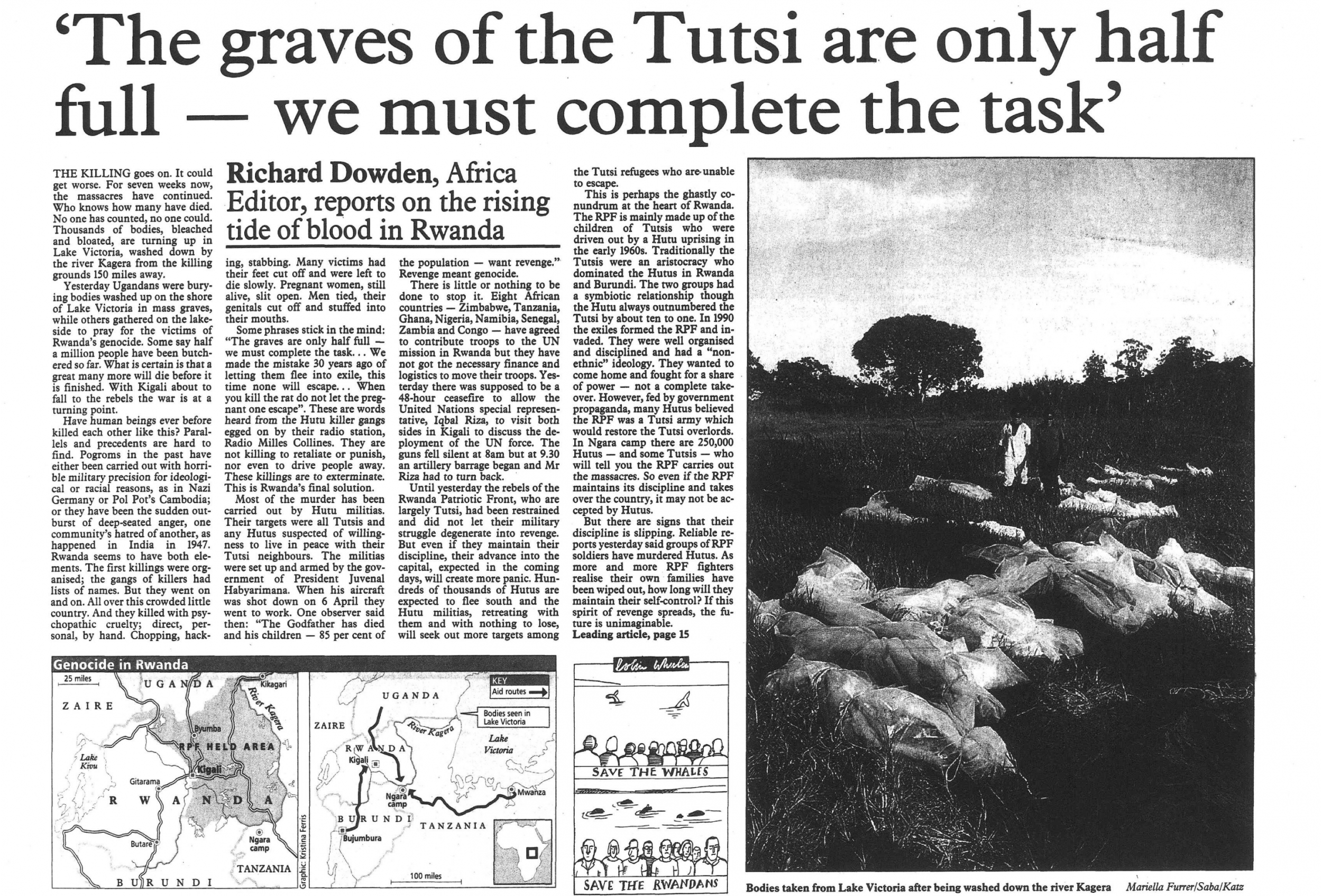A witness to genocide
Between half a million and a million Rwandans, mostly from the Tutsi ethnic group, were victims of a mass slaughter

24 May 1994
The killing goes on. It could get worse. For seven weeks now, the massacres have continued. Who knows how many have died. No one has counted, no one could. Thousands of bodies, bleached and bloated, are turning up in Lake Victoria, washed down by the river Kagera from the killing grounds 150 miles away.
Yesterday Ugandans were burying bodies washed up on the shore of Lake Victoria in mass graves, while others gathered on the lakeside to pray for the victims of Rwanda’s genocide. Some say half a million people have been butchered so far. What is certain is that a great many more will die before it is finished. With Kigali about to fall to the rebels the war is at a turning point.
Have human beings ever before killed each other like this? Parallels and precedents are hard to find. Pogroms in the past have either been carried out with horrible military precision for ideological or racial reasons, as in Nazi Germany or Pol Pot’s Cambodia; or they have been the sudden outburst of deep-seated anger, one community’s hatred of another, as happened in India in 1947. Rwanda seems to have both elements. The first killings were organised; the gangs of killers had lists of names. But they went on and on. All over this crowded little country. And they killed with psychopathic cruelty; direct, personal, by hand. Chopping, hacking, stabbing. Many victims had their feet cut off and were left to die slowly. Pregnant women, still alive, slit open. Men tied, their genitals cut off and stuffed into their mouths.
Some phrases stick in the mind: ‘‘The graves are only half full – we must complete the task ... We made the mistake 30 years ago of letting them flee into exile, this time none will escape ... When you kill the rat do not let the pregnant one escape’’. These are words heard from the Hutu killer gangs egged on by their radio station, Radio Milles Collines. They are not killing to retaliate or punish, nor even to drive people away. These killings are to exterminate. This is Rwanda’s final solution.
Most of the murder has been carried out by Hutu militias. Their targets were all Tutsis and any Hutus suspected of willingness to live in peace with their Tutsi neighbours. The militias were set up and armed by the government of President Juvenal Habyarimana. When his aircraft was shot down on 6 April they went to work. One observer said then: ‘‘The Godfather has died and his children – 85 per cent of the population – want revenge.’’ Revenge meant genocide.
There is little or nothing to be done to stop it. Eight African countries – Zimbabwe, Tanzania, Ghana, Nigeria, Namibia, Senegal, Zambia and Congo – have agreed to contribute troops to the UN mission in Rwanda but they have not got the necessary finance and logistics to move their troops. Yesterday there was supposed to be a 48-hour ceasefire to allow the United Nations special representative, Iqbal Riza, to visit both sides in Kigali to discuss the deployment of the UN force. The guns fell silent at 8am but at 9.30 an artillery barrage began and Mr Riza had to turn back.
Until yesterday the rebels of the Rwanda Patriotic Front, who are largely Tutsi, had been restrained and did not let their military struggle degenerate into revenge. But even if they maintain their discipline, their advance into the capital, expected in the coming days, will create more panic. Hundreds of thousands of Hutus are expected to flee south and the Hutu militias, retreating with them and with nothing to lose, will seek out more targets among the Tutsi refugees who are unable to escape.
This is perhaps the ghastly conundrum at the heart of Rwanda. The RPF is mainly made up of the children of Tutsis who were driven out by a Hutu uprising in the early 1960s. Traditionally the Tutsis were an aristocracy who dominated the Hutus in Rwanda and Burundi. The two groups had a symbiotic relationship though the Hutu always outnumbered the Tutsi by about ten to one. In 1990 the exiles formed the RPF and invaded. They were well organised and disciplined and had a ‘‘non- ethnic’’ ideology. They wanted to come home and fought for a share of power – not a complete takeover. However, fed by government propaganda, many Hutus believed the RPF was a Tutsi army which would restore the Tutsi overlords. In Ngara camp there are 250,000 Hutus – and some Tutsis – who will tell you the RPF carries out the massacres. So even if the RPF maintains its discipline and takes over the country, it may not be accepted by Hutus.
But there are signs that their discipline is slipping. Reliable reports yesterday said groups of RPF soldiers have murdered Hutus. As more and more RPF fighters realise their own families have been wiped out, how long will they maintain their self-control? If this spirit of revenge spreads, the future is unimaginable.
Join our commenting forum
Join thought-provoking conversations, follow other Independent readers and see their replies
Comments
Bookmark popover
Removed from bookmarks